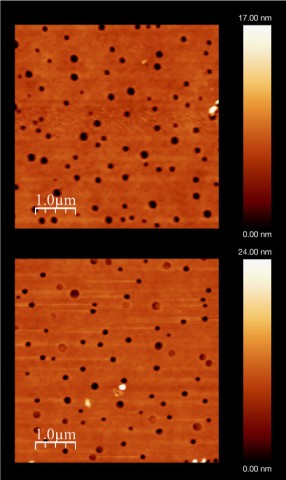Feb 2 2015
A research team from the Okinawa Institute of Science and Technology (OIST) Graduate University have discovered a significant problem in the next-generation solar cells being developed. The top layer of these solar cells are covered with tiny pinholes.
 Atomic Force Microscopy (AFM) images show pinholes in the spiro-MeOTAD when it is first prepared (top) and after air exposure for 24 hours (bottom). The average diameter of the pinholes is about 135nm, with some as large as 2µm. (Photo credit: OIST)
Atomic Force Microscopy (AFM) images show pinholes in the spiro-MeOTAD when it is first prepared (top) and after air exposure for 24 hours (bottom). The average diameter of the pinholes is about 135nm, with some as large as 2µm. (Photo credit: OIST)
Most of the solar cells under development are constructed using materials such as spiro-MeOTAD and perovskite. Compared to the conventional silicon-based solar cells, these solar cells are inexpensive and they feature a much higher effciency. However, the perovskite layer, which converts sunlight to electricity, deteriorates faster.
The analysis conducted by the OIST researchers now reveals what the real problem is. The spiro-MeOTAD layer has several tiny pinholes, some of which cannot even be viewed using a light microscope. Water and other gas molecules in air enter via these pinholes, spread through the thin film and degrade the perovskite.
“These pinholes may play a major role in the degradation of the lifetime of the solar cells,” said Zafer Hawash, a PhD student at OIST who discovered the pinholes. The student’s analysis can be found in the journal Chemistry of Materials.
Hawash observed these pinholes when he was testing the manner in which air interacted with the spiro-MeOTAD. He became more interested in the pinholes when he realized that they were not mentioned in any scientific literature.
“No one has really mentioned this,” said Hawash, who works in OIST’s Energy Materials and Surface Sciences Unit and is the lead paper author. “I started realizing it was something important to report, to let people know these pinholes exist and that we should get rid of them to get better lifetime.”
On closer observation, the pinholes appeared to be connected to the way in which the spiro-MeOTAD layer is manufactured. The process requires a solution to be spin-coated onto a base layer to produce a thin film, which is a very small fraction of the thickness of a human hair.
According to Dr. Luis Ono, an Energy Materials and Surface Sciences Unit group leader and paper co-author, another manufacturing method, which uses vacuum evaporation, did not generate pinholes.
The research team is now focused on finding ways to remove the pinholes while managing to keep the costs low. They are considering to either modify the manufacturing method or adding new ingredients.
“Currently we are making efforts in finding a way to fix the problem of the pinholes,” said Professor Yabing Qi, who heads the Energy Materials and Surface Sciences Unit.
This discovery will be beneficial to the already ongoing research work on perovskite solar cells to overcome its weakness and produce cost-effective solar power.